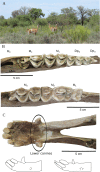Lama guanicoe remains from the Chaco ecoregion (Córdoba, Argentina): An osteological approach to the characterization of a relict wild population
- PMID: 29641579
- PMCID: PMC5894973
- DOI: 10.1371/journal.pone.0194727
Lama guanicoe remains from the Chaco ecoregion (Córdoba, Argentina): An osteological approach to the characterization of a relict wild population
Abstract
Guanacos (Lama guanicoe) are large ungulates that have been valued by human populations in South America since the Late Pleistocene. Even though they were very abundant until the end of the 19th century (before the high deforestation rate of the last decades), guanacos have nearly disappeared in the Gran Chaco ecoregion, with relicts and isolated populations surviving in some areas, such as the shrubland area near the saline depressions of Córdoba province, Argentina. In this report, we present the first data from a locally endangered guanaco wild population, through the study of skeletal remains recovered in La Providencia ranch. Our results showed that most of the elements belonged to adults aged between 36 and 96 months; sex evaluation showed similar numbers of males and females. Statistical analysis of the body size of modern samples from Córdoba demonstrated that guanacos from the Chaco had large dimensions and presented lower size variability than the modern and archaeological specimens in our database. Moreover, they exhibited dimensions similar to those of modern guanacos from Patagonia and San Juan, and to archaeological specimens from Ongamira and Cerro Colorado, although further genetic studies are needed to corroborate a possible phylogenetic relationship. Finally, we used archaeozoological techniques to provide a first characterization of a relict guanaco population from the Chaco ecoregion, demonstrating its value to the study of modern skeletal remains and species conservation biology.
Conflict of interest statement
Figures





References
-
- Raedeke KJ. Population dynamics and socioecology of the Guanaco (Lama guanicoe) of Magallanes. Chile. PhD dissertation. College of Forest Resources. University of Washington. Seattle (Ann Arbor, University Microfilms International). 1979. Available from: https://dlib.lib.washington.edu/researchworks/handle/1773/5460. Cited March 2016.
-
- Mengoni Goñalons, GL. Cazadores de Guanacos de la estepa patagónica. Sociedad Argentina de Antropología, Colección Tesis Doctorales. Buenos Aires; 1999.
-
- Izeta AD. Interspecific Differentiation of South American Camelids on Archaeofaunal Calchaquíes Valleys (Argentina) In: Gutiérrez M., Barrientos G., Mengoni-Goñalons G., Miotti y L. Salemme M., editors. Tafonomía y Zooarqueología Argentina. BAR International Series; 2007. pp. 47–57.
-
- Kaufmann C. Estructura de sexo y edad en guanaco. Estudios actualísticos y arqueológicos en Pampa y Patagonia. Colección Tesis Doctorales, Sociedad Argentina de Antropología, Buenos Aires; 2009.
-
- Martínez G, Gutiérrez M. Tendencias en la explotación humana de la fauna durante el Pleistoceno final y Holoceno en la Región Pampeana (Argentina) In Mengoni Goñalons G. editor. Zooarchaeology of South America; 1298; 2004. pp.81–91.
Publication types
MeSH terms
LinkOut - more resources
Full Text Sources
Other Literature Sources

